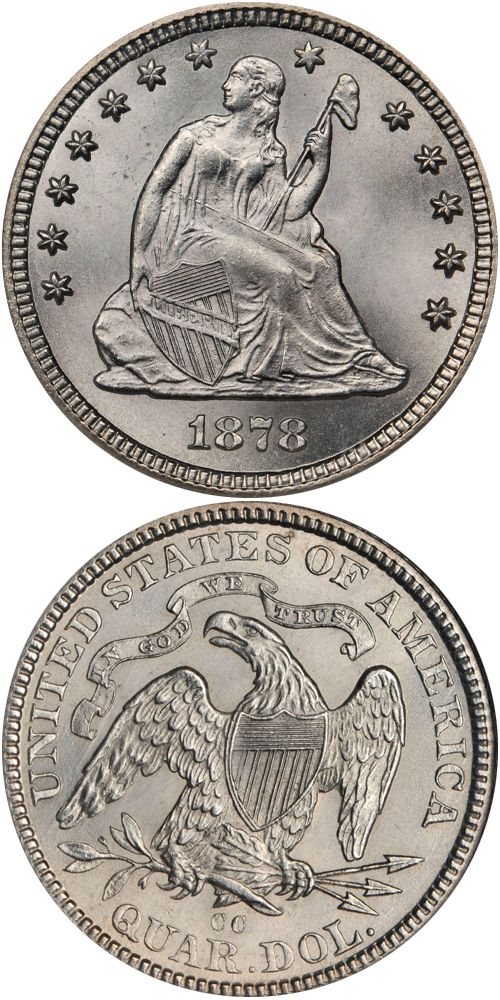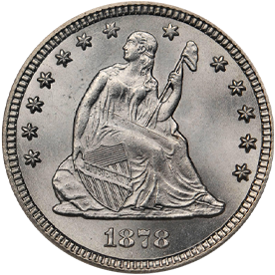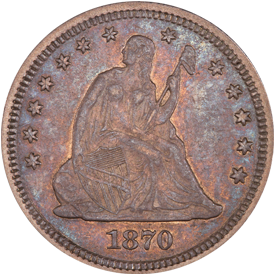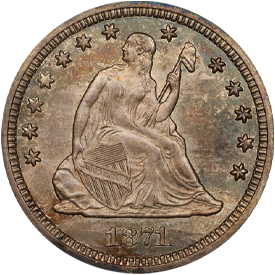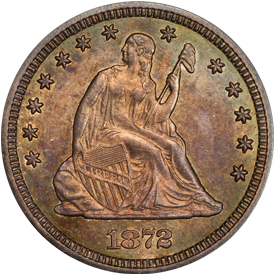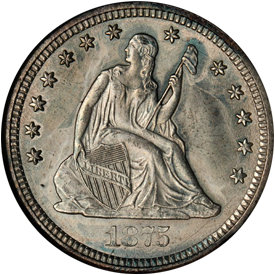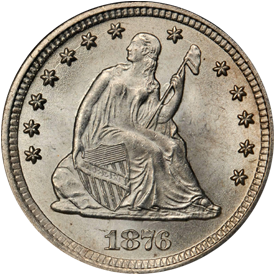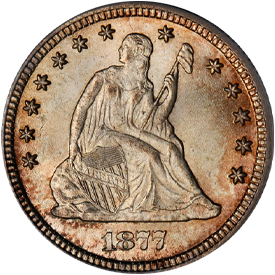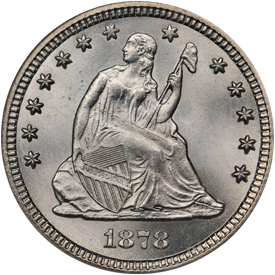Designed by: Christian Gobrecht
Issue Dates: 1866-1873, 1875-1891
Composition: 90% silver, 10% copper
Diameter: 24.3 mm
Weight: 6.22 grams (95.98 grains, 1866 to 1873), 6.25 grams (96.45 grains, 1875-1891)
Edge: Reeded
Business Strike Mintage: 72,680,181
In 1866 the motto IN GOD WE TRUST was added to the reverse of the Liberty Seated quarter dollar, half dollar, and silver dollar. The Liberty Seated obverse in combination with the eagle reverse with added motto was continued in use through 1891. A distinctly different type is represented by certain issues of 1873 and all quarter dollars of 1874 with arrows at the date. Mintage was continuous from 1866 through 1891 at the Philadelphia Mint. In addition, the San Francisco and Carson City mints produced many coins. The only New Orleans issue of the type is the 1891-O, made during the last year the design was in use. There are a number of rarities within the span, with top honors being held by the 1873-CC (variety without arrows at date) of which just two specimens are known to exist.
The type set collector will have no difficulty acquiring an example of one of the common dates in this span in grades from Good through Very Fine or so, although it is the case that Liberty Seated quarters of this era are much scarcer than contemporary dimes and are slightly scarcer than half dollars. Extremely Fine pieces can be found with some searching, AU coins are scarcer, Uncirculated pieces are scarcer yet, and superb Uncirculated pieces are rare. Proofs are available in proportion to the original mintages.
Further Reading
In 1856 the without-arrows style was resumed. This motif continued through 1866, at which time the motto IN GOD WE TRUST appeared on the reverse.
The Carson City Mint first produced quarters from Comstock Lode silver in 1870. Specimens of the years 1870 through 1873 are rare in all grades, with Uncirculated specimens being extreme rarities. One of the great landmarks in American coinage is provided by the 1873-CC without arrows, of which only two specimens are known to the author, one which appeared in the James Stack estate (and which was offered subsequently by my firm) and the other being in the Louis Eliasberg Collection. Although a mintage of 4,000 was reported for 1873-CC without arrows, it is probably the situation that all were melted except for just a few saved for assay purposes. Such pieces were sent to Philadelphia to be part of the Assay Commission's meeting the following year, early in 1874 (when the preceding year's coinage was reviewed). It was occasionally the practice that such pieces reserved for assay were made available to collectors through the curator of the Mint Collection or possibly through members of the Assay Commission who obtained examples legally by exchanging current pieces for them. In any event, over the years such assay pieces have surfaced for a number of issues.
Carson City quarters of 1876 and 1877 were made in large quantities, so these are readily available today, including examples in Uncirculated grade.
From 1879 through the late 1880s the Philadelphia Mint was busy turning out tons of silver dollars each year, so little attention was made to making other silver coins, particularly quarters and half dollars. The result was that a series of rarities was created. In the quarter dollar denomination, the low water mark was reached in 1886 when just 5,000 business strikes plus 886 Proofs left the presses. The low mintages of 1879-1890 quarters have made them perennial favorites with numismatists.
The 1891-O quarter dollar is distinctive as it is the only New Orleans Mint issue produced after 1860-O and thus is the only New Orleans Liberty Seated quarter with IN GOD WE TRUST on the reverse. Specimens are fairly scarce in all grades, for only 68,000 were struck. San Francisco produced Liberty Seated quarters intermittently from 1855 through 1891, with no coinage occurring from 1879 through 1890 inclusive. Although catalogues list such items as 1867-S, 1868-S, 1869-S, 1871-S, 1872-S, and others, the 1870-S is not recorded. The discovery of an 1870-S half dime, likewise unrecorded and previously unknown, prompted me to wonder whether there is such a thing as an 1870-S quarter.
In Uncirculated grade, Liberty Seated quarters from 1856 through 1891 (the earlier issues having been discussed previously) are for the most part scarce, although occasionally examples dated in the 1870s, including the already-noted 1876-CC and 1877-CC, can be found. Perhaps the most plentiful varieties are the 1876-S and 1877-S. Uncirculated New Orleans coins in this range, of which there are only a few scattered issues, are exceedingly elusive, and San Francisco quarters of the years prior to 1874 are rarities. A group of Uncirculated 1874-S half dollars came to light about 20 years ago from a reputed Mexican source and were distributed by Lester Merkin. My firm handled a number of these, around 40 or so, and each one was MS-63 or better by today's standards. While business strikes of nearly all Liberty Seated quarters are elusive, when Uncirculated specimens of the 1879-1890 years come on the market, they usually sell for record prices. The survival of such pieces was a matter of chance, and as most collectors preferred Proofs (which were readily available from the Mint at the time), not many of these low-mintage business strikes survived.
In worn grades later Liberty Seated quarters exist in approximate percentage to their mintages. In general, as of the present writing I consider Liberty Seated quarters to be among the greatest sleepers in the American market. I am not referring only to landmark rarities or low-mintage issues, I am equally referring to so-called "common dates" in such grades as Fine, Very Fine, and Extremely Fine. While relatively large quantities exist of Liberty Seated dimes of this era, and while half dollars are readily acquired, a survey of dealers' stocks show that high-grade circulated specimens of quarters are a very elusive commodity. This situation has received little publicity, has never been the subject of any popular investment writing, and in general has been ignored – simply because no one has had a vested interest. The pieces are legitimately hard to find!
Proof Liberty Seated quarters were first openly distributed to collectors in 1858, when 80 examples were sold. From 1859 through 1890 usually 600 to 800 Proofs were struck each year, with some mintages dipping below or rising above this median. Probably 50% to 70% of these exist today, although numerous examples have been harshly cleaned or mishandled. Coins which qualify as Proof-63 or Proof-65 by today's standards, pieces dated from 1858 through the early 1870s, are especially difficult to locate. Proofs of 1873 and 1874 with arrows are more expensive due to their status as type coins, and Proofs of the years 1879 through 1890 have added popularity due to the low mintages of the related business strikes. As is the case with Liberty Seated dimes, the completion of a set of Proof quarters of the 1858-1891 span would probably take a year or more to put together, especially if Proof-63 or better coins are desired.
